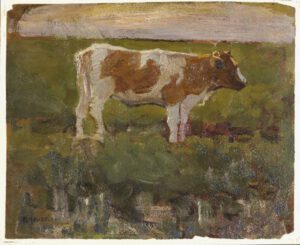Liviana Martin

Piet Mondrian, whom we know as a painter of abstraction and a destroyer of naturalistic forms, was a figurative artist at the beginning of his career. The current exhibition at the MUDEC (Museo delle Culture) in Milan presents the path taken by the artist (1872-1944) from figuration to the turning point of neoplasticism, comparing his paintings with the works of the Hague School, of which he was part.
Around 1870, a group of young artists revolutionized Dutch painting, rejecting the idealized subjects of the Romantic era in favor of a more realistic painting style. Landscape paintings depicted windmills, canals, flowers, churches and villages, set in the typical flat Dutch landscape. The origins of Mondrian’s painting lie in this context. Driven by a strong sense of innovation, the artist tried to capture the absolute essence of the surrounding world, a rhythm of surfaces and colors, of horizontal and vertical lines. However, only by observing the real world precisely could he achieve pure abstraction. The landscape was the journey through which he remained faithful to the roots of the Dutch tradition and at the same time revolutionized the history of art.
In his writings the artist says that as a young man he loved to paint landscapes seen under a grey sky or struck by a very strong light. He also painted in the moonlight – cows crouched or standing motionless on the meadows were among his favorite subjects. The countryside around Amsterdam was one of his most beloved places: masterpieces such as Windmill in the Evening were born, or The Mill on the River Gein, which he portrayed at least 25 times. Mondrian preferred intense, bright colors, which he would later use for his abstract works.
Starting from 1900, he abandoned the faithful representation of nature to experiment with new shapes and colors, to reduce the world to its absolute essence: planes, colors and lines. His inspiration also derived from theosophy, a philosophical current of the second half of the 19th century, which wanted to free man from the individual ‘mud of reality’ to draw on universal reality. The works carried out after 1908 (such as Two Calla, or Calla, Blue Flower) demonstrate his search for the essence of flowers (in nature the petals of the calla lilies are white).
His cows are dashed with brushstrokes of white, black and orange, the irrigation channels are rendered in flat colors, the willows in the foreground reinforce the lack of depth. The path to abstraction is now defined. Undoubtedly his Calvinist faith also influenced his art, which refuses to define the divine in terms of images in anything that can be circumscribed. Here, in the same way, the destruction of the realistic image proclaimed by Mondrian is linked to the deepest essence of all that exists.
Even the places where Mondrian lived, from the suburbs of Amsterdam, to Paris, to London during the war, and finally to New York, where he died in 1944, undoubtedly affected his artistic path: passing from the quiet Dutch spaces to the great capitals of modernity, Mondrian must take into account the profound contrast between the life of the province and that of the metropolis. The city, of which New York is the symbol, is permeated by an incessant rhythm, by the lights always on, which he reproduces in his abstract compositions. Mondrian finds many similarities between his paintings and the jazz bands: intuition and improvisation were fundamental for both the artist and the jazz musicians. Even jazz music is ‘rhythm in freedom’, without allusion to a plot, just as Mondrian’s painting does not refer to the natural world. In jazz, the artist finds the musical equivalent of Neoplasticism.
Mondrian said that in his early works he was a figurative realist and in later ones an abstract realist. “For me there is no difference between the first and the last works: they are all part of the same thing. I don’t feel the difference between the old and the new in art, but the continuity.”
The starting point is The Village Church of 1898, the finish line is Composition of 1929.
And the circle closes.
Piet Mondrian – From Figuration to Abstraction MUDEC, Milan – from 24/11/2021 to 27/03/2022, Tickets 14 euro
Volume 36 no 4 March/April 2022
